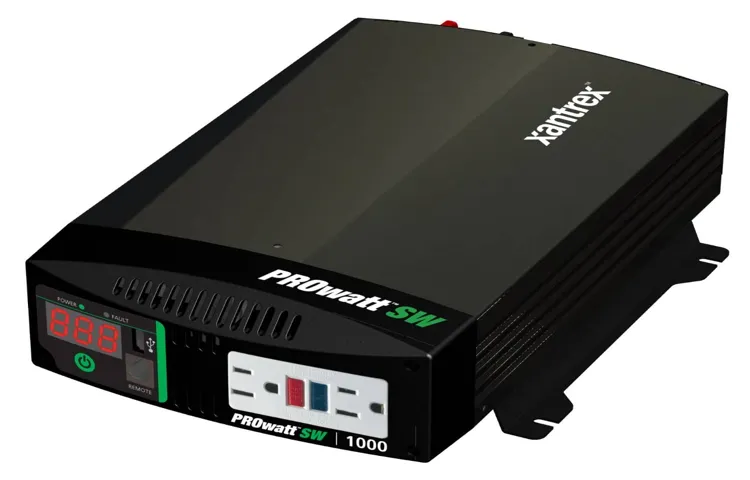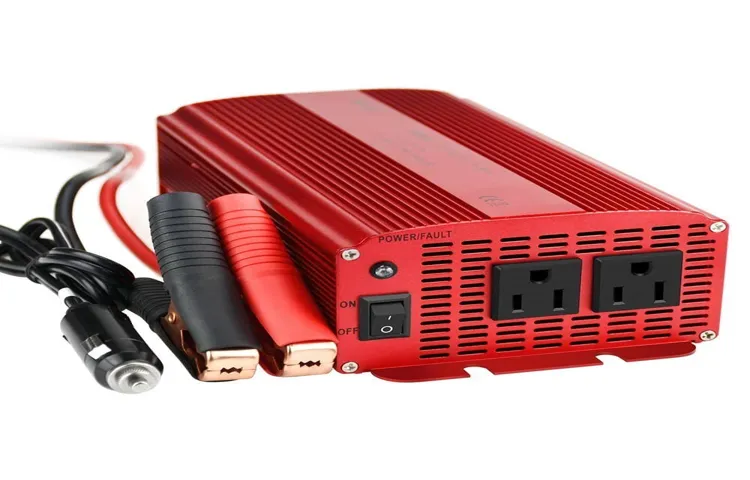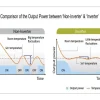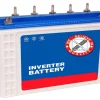Power consumption is an important factor to consider when using inverters. Whether it’s for your home, office, or outdoor activities, understanding the power consumption of inverters can help you make informed decisions and avoid any unpleasant surprises. Inverters are devices that convert direct current (DC) power from a battery or solar panels into alternating current (AC) power, which is what most electrical appliances and devices run on.
They are widely used in various applications, such as powering appliances during power outages, running off-grid systems, or even charging electric vehicles. But how much power do inverters consume themselves? And how does it impact the overall power usage of your system? These are questions that many people often wonder about. Just like any electrical device, inverters have their own power consumption.
When the inverter is in operation, it requires a small amount of power to convert DC to AC. This power consumption is usually referred to as the “no-load power” or “standby power.” It is the power that the inverter consumes even when there is no load connected to it.
However, the power consumption of inverters is relatively low compared to the power they can deliver. Most modern inverters have impressive efficiency ratings, meaning they can convert a large percentage of the input power into usable AC power. This efficiency can range from around 80% to over 95%, depending on the quality and design of the inverter.
To put it in perspective, think of the inverter as a traffic cop directing the flow of electricity. It ensures that the power from the battery or solar panels is directed to the appliances and devices that need it. Just like a traffic cop, the inverter has a small power consumption itself to perform its job effectively.
Knowing the power consumption of your inverter is crucial for several reasons. Firstly, it helps you estimate the total power usage of your system. By factoring in the power consumption of the inverter, you can better understand how much power you can expect to be available for your devices.
Table of Contents
What is an Inverter?
When it comes to inverters, one question that often comes up is, “how much power does an inverter use?” The power consumption of an inverter largely depends on its size and the load it is powering. In general, larger inverters will use more power because they have a higher capacity. However, this doesn’t mean that all inverters consume a significant amount of power.
In fact, modern inverters are designed to be highly efficient, meaning that they convert DC power from a battery or solar panels into AC power with minimal energy loss. So, while it’s true that an inverter does use some power, it is usually a small percentage of the total power being generated. Ultimately, the amount of power an inverter uses will depend on the specific model and its usage scenario.
Factors Influencing Power Consumption
Have you ever wondered how much power an inverter uses? Well, the power consumption of an inverter can vary depending on several factors. Firstly, the size or capacity of the inverter plays a significant role. Generally, larger inverters with higher capacity tend to consume more power.
Additionally, the load or the appliances connected to the inverter also affect power consumption. If you have multiple high-power devices running simultaneously, the inverter will consume more power. Furthermore, the efficiency of the inverter itself is a crucial factor.
Inverters with higher efficiency ratings generally consume less power. Finally, the input voltage of the inverter can also impact power consumption. Higher input voltage can reduce power consumption.
So, when considering the power usage of an inverter, it’s important to take into account its size, load, efficiency, and input voltage.

1. Size and Efficiency of the Inverter
inverter size and efficiency, power consumption, factors influencing power consumption
2. Power Load
One of the key factors that influences power consumption is the power load. Power load refers to the amount of electrical energy consumed by various devices and appliances in a given period. Think about it like the amount of weight you have to lift at the gym – the heavier the load, the more energy and effort you need to exert.
Similarly, when we have a high power load, it requires more electricity to meet the demand. This can be influenced by factors such as the number and type of devices being used, the duration of their usage, and their power ratings. For example, using multiple high-power appliances such as air conditioners, refrigerators, and washing machines simultaneously will result in a higher power load and therefore higher power consumption.
On the other hand, using energy-efficient devices or turning off unused appliances can help reduce the power load and ultimately save energy. So, it’s important to be mindful of the power load and make conscious choices to optimize our power consumption.
3. Operating Conditions
In addition to the design and capacity of the equipment, there are several operating conditions that can significantly impact power consumption. One key factor is the environment in which the equipment operates. For example, if the equipment operates in a hot and humid environment, it may require more energy to cool itself down, resulting in higher power consumption.
Similarly, if the equipment operates in a cold environment, it may require more energy to heat itself up, again increasing power consumption. Another important factor is the load on the equipment. If the equipment is consistently operating at or near its maximum capacity, it will consume more power than if it were operating at a lower load.
Additionally, factors such as voltage fluctuations, harmonics, and power factor can also affect power consumption. Overall, it is crucial for businesses to carefully consider these operating conditions and their potential impact on power consumption in order to optimize efficiency and minimize energy costs.
Calculating Power Consumption of an Inverter
Have you ever wondered how much power an inverter uses? Well, the power consumption of an inverter depends on several factors such as its size, efficiency, and load. Inverters are devices that convert DC power from a battery into AC power that can be used to run appliances and electronics. The size of the inverter refers to its power rating, which is usually measured in Watts.
The higher the power rating, the more power the inverter is capable of supplying. However, it’s important to note that the power rating of an inverter does not necessarily determine its power consumption. The efficiency of the inverter is also a crucial factor to consider.
An efficient inverter will convert more of the DC power from the battery into AC power, resulting in lower power consumption. Additionally, the load connected to the inverter also affects its power consumption. If you have multiple appliances connected to the inverter, it will draw more power.
So, when calculating the power consumption of an inverter, it’s essential to consider these factors to get an accurate estimate.
1. Finding the Inverter’s Input Power
Calculating the power consumption of an inverter may seem like a complicated task, but it’s actually quite simple once you understand the basic principles. The first step in this process is finding the inverter’s input power. The input power refers to the amount of power that the inverter needs to operate properly.
To determine this, you will need to know the voltage and current ratings of your inverter. These ratings are usually provided by the manufacturer and can be found in the inverter’s specifications. To calculate the input power, you simply multiply the voltage and current ratings together.
For example, if your inverter has a voltage rating of 12 volts and a current rating of 10 amps, the input power would be 120 watts (12 volts * 10 amps = 120 watts). It’s important to note that the input power does not necessarily reflect the amount of power the inverter will consume from your electricity source. Inverters are not 100% efficient and will have some power losses during the conversion process.
These losses are usually small, but they can add up over time. Calculating the power consumption of an inverter is an essential step in understanding its overall efficiency and performance. By determining the input power, you can get a better idea of how much power the inverter will require and plan your energy usage accordingly.
So, the next time you’re considering using an inverter, be sure to calculate its power consumption to make informed decisions about your energy usage.
2. Determining the Conversion Efficiency
power consumption of an inverter, calculating conversion efficiency, power loss in an inverter Have you ever wondered how much power your inverter consumes? Understanding the power consumption of an inverter is crucial for determining its efficiency and overall performance. When we talk about power consumption, we are referring to the amount of electrical power that is used by the inverter to convert DC power from a battery or solar panel into AC power that can be used to power appliances and devices. Calculating the power consumed by an inverter involves considering the conversion efficiency and power losses.
Conversion efficiency is the ratio of output power to input power, and it determines how well the inverter can convert DC power to AC power. The higher the conversion efficiency, the less power is wasted during the conversion process. Power losses in an inverter result from factors such as heat dissipation, harmonic distortion, and internal resistance.
By assessing these factors, we can calculate the power consumption of the inverter and determine its overall efficiency. So, if you want to ensure that your inverter is operating efficiently and minimizing power losses, it’s essential to calculate its power consumption accurately.
3. Calculating the Power Consumption
power consumption, inverter, calculating power consumption Have you ever wondered how much power your inverter consumes? Calculating the power consumption of an inverter is essential for understanding its efficiency and determining its impact on your electricity bill. To calculate the power consumption, you need to consider two factors: input power and efficiency. The input power refers to the amount of power that the inverter receives from the electrical supply.
This power is then converted and delivered as output power. Efficiency, on the other hand, is the ratio of output power to input power. A more efficient inverter will convert a higher percentage of the input power into output power, resulting in lower power consumption.
To calculate the power consumption, you can multiply the input power by the inverse of the efficiency. For example, if the input power is 500 watts and the efficiency is 90%, the power consumption would be 500 watts divided by 0.9, which is approximately 556 watts.
By understanding and calculating the power consumption of your inverter, you can make informed decisions about energy usage and potentially save on your electricity bill.
Example Calculation
Have you ever wondered how much power an inverter uses? Well, let’s break it down. An inverter works by converting DC power from a battery into AC power that can be used to run household appliances. The amount of power an inverter uses depends on a few factors.
Firstly, the size of the inverter can affect its power consumption. A larger inverter will typically use more power than a smaller one. Additionally, the amount of power being drawn from the inverter also impacts its energy usage.
If you have multiple appliances running at the same time, the inverter will need to work harder and therefore use more power. It’s important to consider these factors when choosing an inverter for your needs, as it can have an impact on your overall energy usage.
Tips for Reducing Inverter Power Consumption
If you’re wondering how much power an inverter uses, you’re not alone. Many people are concerned about keeping their energy consumption as low as possible. Fortunately, there are several tips you can follow to reduce inverter power consumption.
One of the simplest ways is to choose an inverter with a higher efficiency rating. Inverters that are more efficient will convert more of the DC power from your battery into AC power for your appliances, reducing the amount of power lost in the conversion process. Additionally, you can also minimize power consumption by using energy-efficient appliances and electronics.
By choosing appliances and electronics with low power consumption, you can reduce the load on your inverter and extend its battery life. Finally, it’s important to remember to turn off your inverter when it’s not in use. This will help prevent unnecessary power drain and promote energy conservation.
So, by following these tips, you can maximize the efficiency of your inverter and decrease your overall power consumption.
1. Choose an Efficient Inverter
Inverters play a crucial role in converting the direct current (DC) produced by solar panels into usable alternating current (AC) for our homes and businesses. However, it’s important to choose an efficient inverter to minimize power consumption and maximize energy savings. Efficiency is measured by the inverter’s ability to convert DC to AC without wasting energy in the process.
By selecting an inverter with a high efficiency rating, you can ensure that the maximum amount of solar-generated electricity is being utilized. This not only reduces electricity bills but also helps to minimize the environmental impact of your solar system. So, when shopping for an inverter, be sure to consider its efficiency rating to make the most of your solar power system.
2. Optimize Power Load
Inverter power consumption is an important consideration when it comes to optimizing power load in your home or office. By reducing the power consumed by your inverter, you can save energy and lower your electricity bills. So, how can you minimize the power used by your inverter? One simple tip is to choose a more efficient inverter model.
Look for inverters that have a higher efficiency rating, as this means they convert a larger percentage of the DC power from your batteries into AC power for your appliances. Additionally, regularly maintaining and cleaning your inverter can help improve its efficiency and reduce power consumption. Another way to minimize power load is by turning off appliances that are not in use.
By only using your inverter when necessary and avoiding unnecessary power consumption, you can achieve significant energy savings. Taking steps to optimize power load not only benefits the environment but also your wallet. So why not start implementing these energy-saving tips today?
3. Maintain Proper Operating Conditions
Tips for Reducing Inverter Power Consumption When it comes to maintaining proper operating conditions for inverters, one of the key considerations is reducing power consumption. Inverters can consume a significant amount of power, which can lead to higher energy costs and decreased efficiency. However, there are a few simple tips you can follow to minimize power consumption and make your inverters more energy-efficient.
Optimize the load: One way to reduce power consumption is to optimize the load connected to the inverter. Make sure that the load is neither too large nor too small for the inverter’s capacity.
If the load is smaller than the inverter’s capacity, it can lead to inefficiencies and unnecessary power consumption. On the other hand, if the load is too large, it can put a strain on the inverter and increase power usage. So, it’s important to find the right balance and choose the appropriate inverter size for your load.
Ensure good ventilation: Inverters generate heat while they are operational. To prevent overheating and improve efficiency, it’s crucial to provide proper ventilation for the inverter.
Make sure that there is enough space around the inverter for airflow and avoid placing it in a confined or enclosed space. Also, keep the surrounding area clean and free from dust or debris that can obstruct the airflow. Good ventilation not only helps in reducing power consumption but also extends the lifespan of the inverter.
Regular maintenance: Regular maintenance is essential to keep your inverters running optimally and to minimize power consumption. Check for any loose connections, damaged cables, or faulty components that could affect the performance of the inverter.
Conclusion
In conclusion, the amount of power an inverter consumes can be compared to a sneaky vampire that quietly sips on your energy while you’re not looking. Just like those mythical creatures, inverters have a knack for disguising their true appetite for power. They may appear harmless, but behind closed doors, they are silently feasting on electricity.
Think of it this way: your inverter is the secret party animal of your electrical system. While you’re busy enjoying the benefits of converting DC to AC power, it’s having a wild time tapping into the energy supply. But unlike a party animal who leaves behind a messy aftermath, inverters are quite efficient in their power consumption.
While it’s true that inverters require energy to operate, their power consumption can vary depending on factors such as the make and model of the device, the load being powered, and the efficiency of the inverter itself. It’s like having a range of party guests with different appetites – some may gobble up energy like a competitive eater, while others are more disciplined and sip on power conservatively. To put it simply, the power usage of an inverter can be as elusive as a carnival magician.
You may try to figure out how much energy it’s consuming, only to be left scratching your head in confusion. But rest assured, modern inverters are designed to be energy-efficient, efficiently converting DC power to AC power while minimizing their own power consumption. So, next time someone asks you how much power your inverter uses, just smile mysteriously and reply with a knowing glint in your eye, “Ah, the power of the inverter is shrouded in mystery, my friend.
It’s like a dancer who gracefully moves to the beat without revealing its true energy consumption, leaving us all captivated.” And there you have it – a clever and witty explanation that highlights the enigmatic nature of an inverter’s power usage. After all, sometimes it’s more fun to leave a little mystery in our daily lives, even when it comes to our electrical appliances.
FAQs
How much power does an inverter use?
The power consumption of an inverter depends on its size and efficiency. Smaller inverters, such as those used for small electronic devices, typically use around 10-100 watts of power. Larger inverters, used for powering appliances or homes, can use several kilowatts of power.
Does an inverter consume power when not in use?
Yes, inverters do consume a small amount of power even when not in use. This is known as the standby power or no-load power consumption. It is usually very low, ranging from a few watts to a few tens of watts, depending on the make and model of the inverter.
How can I calculate the power consumption of an inverter?
To calculate the power consumption of an inverter, you need to know its efficiency and the load it is powering. Multiply the input power (measured in watts) by the load factor (usually expressed as a decimal) to get the power consumed by the inverter. For example, if the input power is 500W and the load factor is 0.8, the power consumption would be 400W.
Does the power consumption of an inverter vary with the type of load?
Yes, the power consumption of an inverter can vary depending on the type of load it is powering. Resistive loads, such as incandescent light bulbs or electric heaters, have a power factor of 1 and do not require any additional power for the inverter to operate. However, reactive loads, such as motors or fluorescent lights, may have a power factor less than 1, which means the inverter will consume additional power to meet the load requirements.
Are there inverters that are more energy-efficient?
Yes, there are inverters that are designed to be more energy-efficient. High-efficiency inverters use advanced power electronics technology to minimize power losses and improve overall efficiency. Look for inverters with a high efficiency rating (usually expressed as a percentage) to ensure you are getting a more energy-efficient option.
Can solar inverters save energy?
Solar inverters are designed to convert the DC (direct current) electricity produced by solar panels into AC (alternating current) electricity that can be used in homes or fed back into the grid. While solar inverters themselves consume a small amount of power, the overall energy savings come from the generation of clean, renewable energy. By utilizing solar power, you can reduce or eliminate the need for traditional electricity, thus saving energy.
How can I minimize the power consumption of an inverter?
To minimize the power consumption of an inverter, you can follow these tips: choose the right size of inverter for your load requirements, select an inverter with a high efficiency rating, avoid overloading the inverter, ensure proper ventilation and cooling to prevent overheating, and consider using energy-efficient appliances and devices that require less power to operate.



